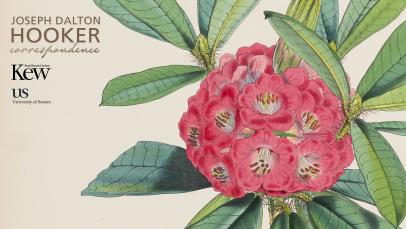JDH informs Ward that the expedition was unable to go to Chatham Islands so he could not get Hypnum Menziesii for Ward. There are very few botanical discoveries to be made in the extreme south latitudes. The wealth of marine animals suggests there should be corresponding plant life but JDH has only found 1 sea plant within Antarctica; a Diatoma. He has found vegetation beyond the previous southern extreme of known plants: Deception Island. He discusses these southerly marine plants: Sargassum natans, Macrocystis pyrifera & a Laminaria brought on currents from New Zealand & propagated at sea by marine animals. The distribution & character of the latter is described at length. Recounts his study of the new Antarctic Diatoma identical to confervoid remains found in fossil powders, & his study of New Zealand mosses incl. a long description of the development of Theca based on dissections of Orthotichum, Dawsonia & Polytrichum & Sclotheimia sp. In general his conclusions agree with Valentine's. His description incl. detailed speculation on Sporule formation, the anatomy of the columellar e.g. in a new species of Entosthodon from Bay of Islands & in other Funaria, & the teeth which connect the peristome to the theca e.g. in Schistostega & Syrrhopodon compared to Syrrhopodon & others. His observations suggest that the distinction of genus Codonoblepharum based on its cone shaped membrane is erroneous. Quotes from his notes on a Campbell Island moss. Speculates on the nature of the annulus. Touches on the mystery of sexes in mosses. States that all this anatomical investigation should aim toward a natural arrangement of mosses, hitherto hampered by ignorance re. geographical distribution & habit. Under date 21 June records his observations on the anatomy of an Orthotrichum & a Sphagnum, incl sketches. Under date July 21 describes: dissection of Voitia, with reference to Brown's description from Parry's Voyage, also the drumhead of Polytrichnum, both incl. illustrations.

The Joseph Dalton Hooker Collection
The Joseph Dalton Hooker Correspondence Project at Kew is making available online the personal and scientific correspondence of the botanist and explorer Sir Joseph Dalton Hooker (1817–1911), Director of the Royal Botanic Gardens’ Kew from 1865-1885. The project was conceived by staff of The University of Sussex and Kew's Library, Art and Archive department and began as a partnership between Kew and the University of Sussex's Centre for World Environmental History. It has been made possible by support from the Stevenson Family Charitable Trust. Letter summaries can be searched through Ɛpsilon, with links to images and transcriptions at the project site at Kew (https://www.kew.org/explore-our-collections/correspondence-collections/joseph-hooker-collections).